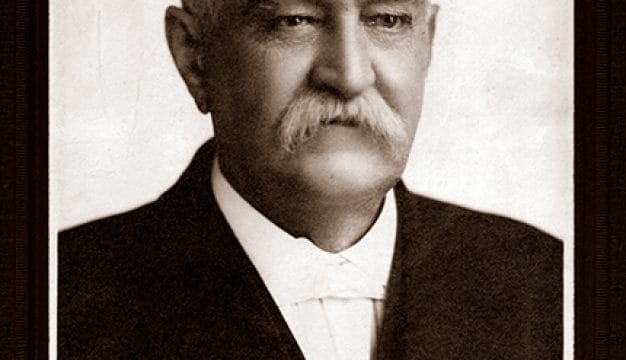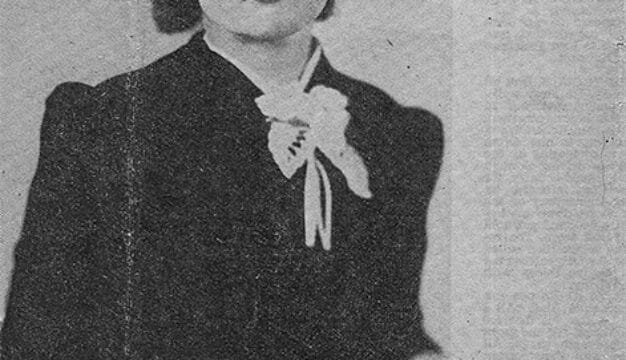John Pelham
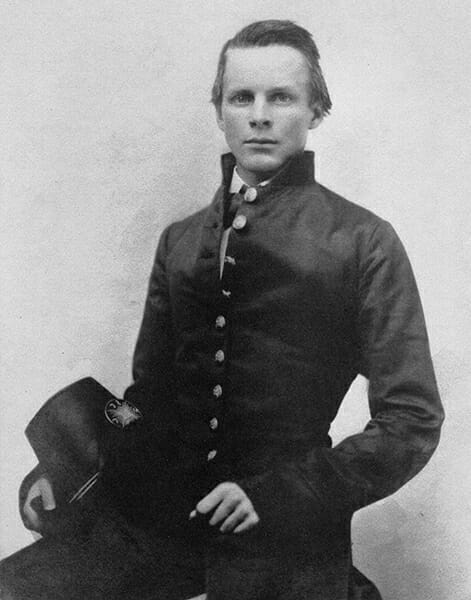 John Pelham
John Pelham (1838-1863) was one of the most noted Confederate artillery officers of the American Civil War. Serving in mostly in Virginia, he organized and commanded James Ewell Brown “Jeb” Stuart’s Horse Artillery. Pelham and the men in his command, many of whom came from the Alabama cities of Mobile and Talladega, made a significant contribution to the early success of the Confederate cavalry, as did his innovative use of light artillery.
John Pelham
John Pelham (1838-1863) was one of the most noted Confederate artillery officers of the American Civil War. Serving in mostly in Virginia, he organized and commanded James Ewell Brown “Jeb” Stuart’s Horse Artillery. Pelham and the men in his command, many of whom came from the Alabama cities of Mobile and Talladega, made a significant contribution to the early success of the Confederate cavalry, as did his innovative use of light artillery.
Pelham was born on September 7, 1838, on the plantation of his maternal grandfather, William McGehee, three miles south of Alexandria, Benton County (present-day Calhoun County). He was the third of eight children born to William and Martha Pelham. His great-grandfather, Peter Pelham, was a noted portrait painter, and his mother was a cousin of noted Kentucky political leader Henry Clay. His brother, Charles Pelham, also served in the Civil War and served one term in the U.S. House of Representatives. Pelham grew up in rural Benton County, where his father practiced medicine and managed a large estate.
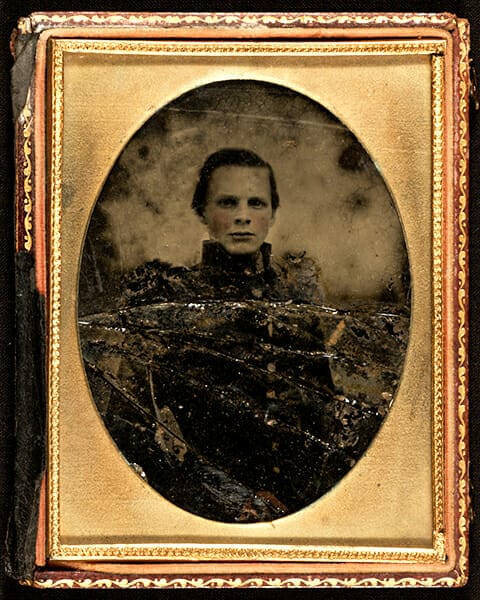 John Pelham
Although Pelham had only some education at the local school and at home, he gained an appointment, through Rep. Sampson W. Harris, to the United States Military Academy at West Point, New York, in 1856. Pelham enjoyed West Point, where he excelled in athletics, ranked highest in cavalry tactics, and was popular with his fellow cadets. During the secession crisis, Pelham, who had invested four and a half years at West Point, hesitated to leave without his diploma. He did not depart when Alabama seceded in January 1861 but waited until after Virginia’s secession in April, as rumors were circulating that cadets who were likely to serve the Confederacy would be arrested. Pelham and fellow cadet and future Confederate general Thomas Rosser submitted their resignations on April 22, 1861, and left the academy only two weeks before graduation.
John Pelham
Although Pelham had only some education at the local school and at home, he gained an appointment, through Rep. Sampson W. Harris, to the United States Military Academy at West Point, New York, in 1856. Pelham enjoyed West Point, where he excelled in athletics, ranked highest in cavalry tactics, and was popular with his fellow cadets. During the secession crisis, Pelham, who had invested four and a half years at West Point, hesitated to leave without his diploma. He did not depart when Alabama seceded in January 1861 but waited until after Virginia’s secession in April, as rumors were circulating that cadets who were likely to serve the Confederacy would be arrested. Pelham and fellow cadet and future Confederate general Thomas Rosser submitted their resignations on April 22, 1861, and left the academy only two weeks before graduation.
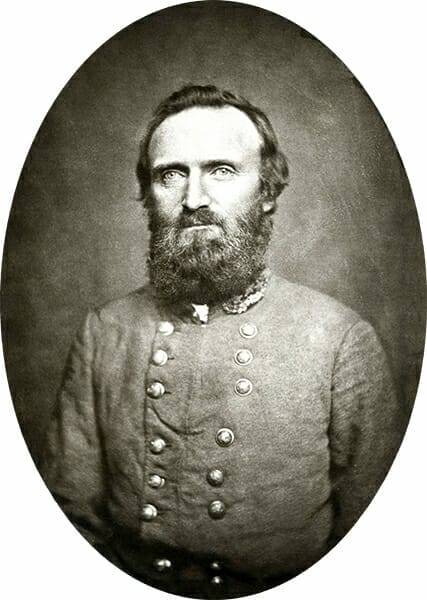 Thomas J. “Stonewall” Jackson
Pelham and Rosser made their way to Pelham’s home, where they drilled new volunteers near Jacksonville, and then went to the Confederate capital at Montgomery to offer their services. Although Pelham desired a commission in the cavalry, the new government needed artillery officers and assigned him to oversee arms and ammunition at Lynchburg, Virginia. Gen. Joseph E. Johnston then called for him to come to Harpers Ferry, Virginia (now West Virginia), to train the new recruits in artillery tactics and skills. In July 1861, Pelham and the Arburtis Battery accompanied Johnston and Gen. Thomas “Stonewall” Jackson to Manassas, Virginia, in what would become known as the First Battle of Bull Run (known as the First Battle of Manassas among Confederates). Pelham and his battery were instrumental in that defeat of U.S. Army forces in the first major battle of the Civil War.
Thomas J. “Stonewall” Jackson
Pelham and Rosser made their way to Pelham’s home, where they drilled new volunteers near Jacksonville, and then went to the Confederate capital at Montgomery to offer their services. Although Pelham desired a commission in the cavalry, the new government needed artillery officers and assigned him to oversee arms and ammunition at Lynchburg, Virginia. Gen. Joseph E. Johnston then called for him to come to Harpers Ferry, Virginia (now West Virginia), to train the new recruits in artillery tactics and skills. In July 1861, Pelham and the Arburtis Battery accompanied Johnston and Gen. Thomas “Stonewall” Jackson to Manassas, Virginia, in what would become known as the First Battle of Bull Run (known as the First Battle of Manassas among Confederates). Pelham and his battery were instrumental in that defeat of U.S. Army forces in the first major battle of the Civil War.
Impressed with the performances of both Stuart and Pelham at Manassas, in the fall of 1861, General Johnston recommended the promotion of Stuart to brigadier general and Pelham to captain and ordered them to organize a mobile artillery unit. Pelham spent the remainder of his service leading the Stuart Horse Artillery and was involved in every engagement with Stuart except for Stuart’s famous ride around Gen. George McClellan’s army during the Peninsular Campaign in 1862.
 John Pelham
Pelham was noted for his modesty, charm and courage and his ability to select the most appropriate ground for the placement of his guns. In spite of his youthful appearance, his men followed him faithfully. His command was a diverse Alabama contingent composed of a dozen men from Talladega, enlisted with the assistance of fellow Alabamian Lt. William McGregor, and the remainder from Mobile with a few from New Orleans. Most of the men from Mobile were French Creoles, whom Pelham called his “Napoleon detachment.” By the summer of 1862, the performance of Pelham and his command earned him a promotion to major. Pelham again provided outstanding service at the Second Battle of Bull Run (Second Manassas), the Battle of Antietam, and during Stuart’s “second ride” around the U.S. Army in October 1862, but his most memorable stand was at Fredericksburg in December 1862. For nearly two hours, Pelham and his men held up the advance of the remaining federal troops with mostly one gun, bringing praise from Gen. Robert E. Lee.
John Pelham
Pelham was noted for his modesty, charm and courage and his ability to select the most appropriate ground for the placement of his guns. In spite of his youthful appearance, his men followed him faithfully. His command was a diverse Alabama contingent composed of a dozen men from Talladega, enlisted with the assistance of fellow Alabamian Lt. William McGregor, and the remainder from Mobile with a few from New Orleans. Most of the men from Mobile were French Creoles, whom Pelham called his “Napoleon detachment.” By the summer of 1862, the performance of Pelham and his command earned him a promotion to major. Pelham again provided outstanding service at the Second Battle of Bull Run (Second Manassas), the Battle of Antietam, and during Stuart’s “second ride” around the U.S. Army in October 1862, but his most memorable stand was at Fredericksburg in December 1862. For nearly two hours, Pelham and his men held up the advance of the remaining federal troops with mostly one gun, bringing praise from Gen. Robert E. Lee.
Pelham’s career however, came to an end the following spring. On March 17, 1863, U.S. Army general William Averell attacked Confederate general Fitzhugh Lee’s cavalry forces to clear them from the upper Rappahannock River in preparation for U.S. Army general Joseph Hooker’s advance toward what became known as the Battle of Kelly’s Ford. At the time, Pelham was in Culpepper, where he had come by train. When notified of the attack, he borrowed a horse and rode to Kelly’s Ford, a crossing on the Rappahannock. He had barely entered the fight when an exploding shell embedded a fragment in the back of his head and penetrated the lower part of his brain. He died in the early hours of the next morning. Stuart considered Pelham irreplaceable, and his death coincided with the decline of Stuart’s cavalry.
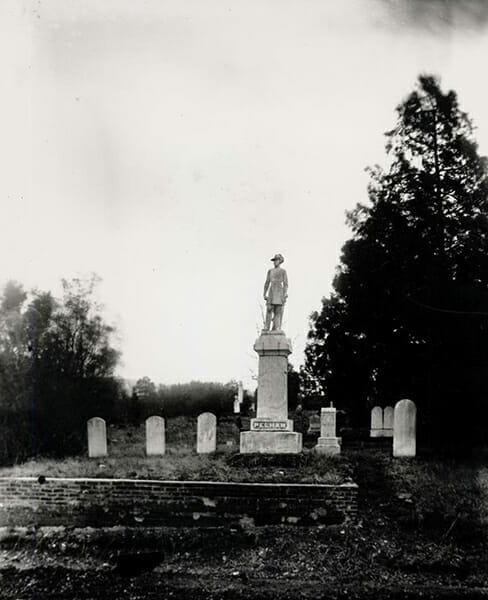 Pelham Grave Site
On April 4, the Confederate Congress promoted Pelham posthumously to the rank of lieutenant colonel, as Stuart and Lee had been recommending for months. His body lay in state in Richmond and then was escorted to Jacksonville for burial. Stuart named his daughter Virginia Pelham, and the towns of Pelham, Alabama, and Pelham, Georgia, are named in honor of him. In 1905, a statue was raised to Pelham in Jacksonville, and in 1927, a monument in his honor was erected along Route 29, the road near Kelly’s Ford where Pelham fell in battle. Several contemporary authors lauded him in their memoirs, including Henry Kyd Douglas, Jedediah Hotchkiss, and Heros Von Borcke, but it was the writings of his tent mate, John Esten Cooke, that earned Pelham the reputation as the ideal young Confederate soldier.
Pelham Grave Site
On April 4, the Confederate Congress promoted Pelham posthumously to the rank of lieutenant colonel, as Stuart and Lee had been recommending for months. His body lay in state in Richmond and then was escorted to Jacksonville for burial. Stuart named his daughter Virginia Pelham, and the towns of Pelham, Alabama, and Pelham, Georgia, are named in honor of him. In 1905, a statue was raised to Pelham in Jacksonville, and in 1927, a monument in his honor was erected along Route 29, the road near Kelly’s Ford where Pelham fell in battle. Several contemporary authors lauded him in their memoirs, including Henry Kyd Douglas, Jedediah Hotchkiss, and Heros Von Borcke, but it was the writings of his tent mate, John Esten Cooke, that earned Pelham the reputation as the ideal young Confederate soldier.
Additional Resources
Cooke, John Esten. Wearing of the Gray. Bloomington: Indiana University Press, 1959.
Hassler, William Woods. Colonel John Pelham: Lee’s Boy Artillerist. Chapel Hill: The University of North Carolina Press, 1960.
The War of the Rebellion: A Compilation of the Official Records of the Union and Confederate Armies. Series I, Volumes XXI and XXV, Parts I and II. Washington, D.C.: Government Printing Office, 1888.
